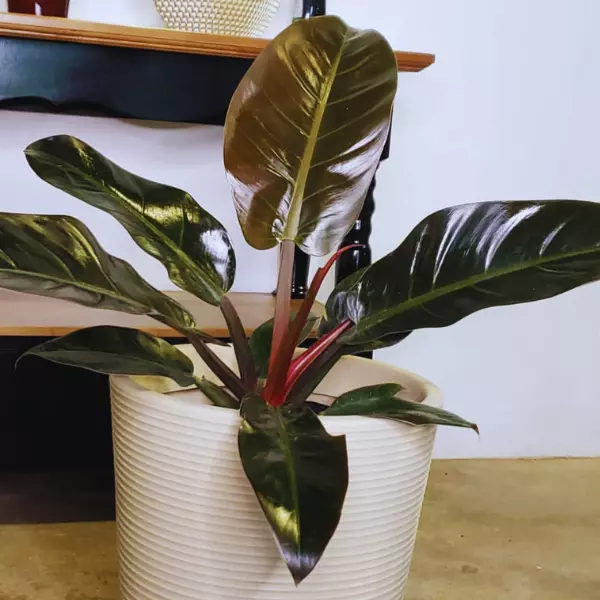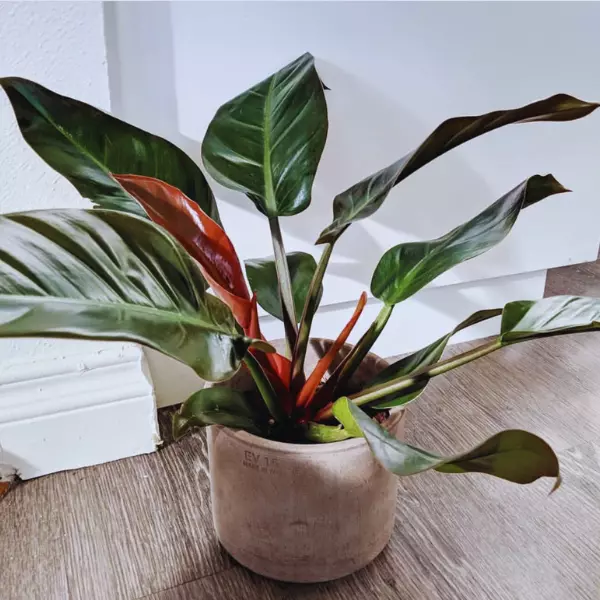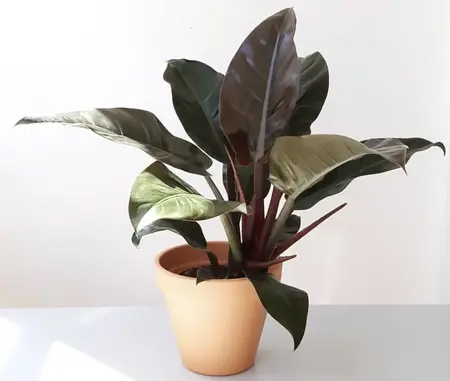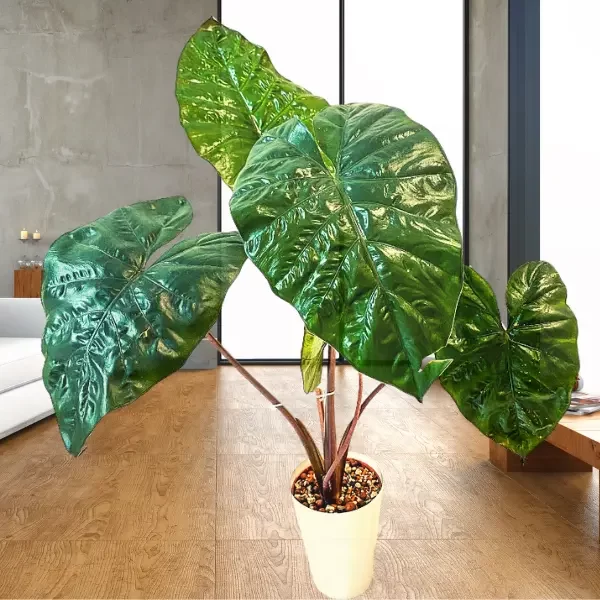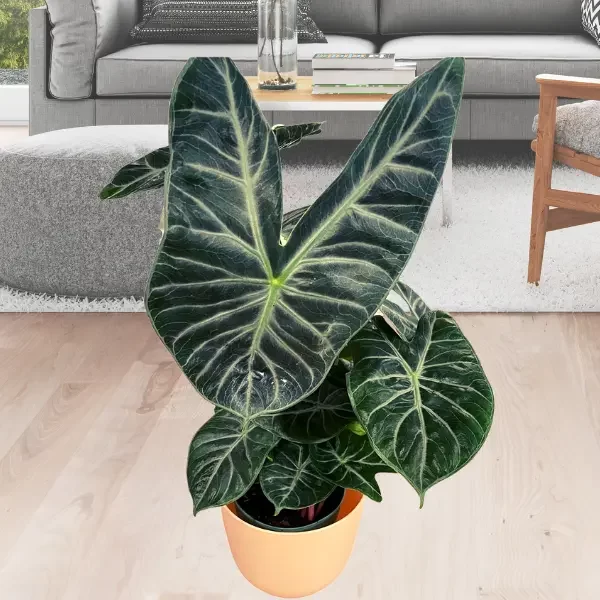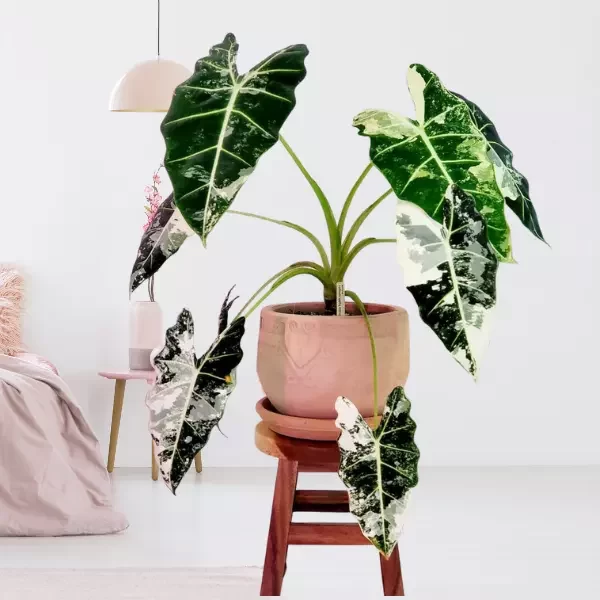The Philodendron Imperial Red, a botanical marvel, epitomizes the perfect fusion of elegance and vibrancy. Botanically known as Philodendron Erubescens, this plant traces its origins to South America’s lush and verdant tropical rainforests. Its exquisite appearance is characterized by lush green leaves, which, upon closer inspection, reveal themselves to be generously brushed with radiant crimson undertones. This striking blend of colors lends the plant an unmistakable charm, making it a sought-after choice for indoor gardening enthusiasts.
Yet, the allure of the Philodendron Imperial Red extends far beyond its visual appeal. This captivating plant doubles as a natural air purifier, enhancing indoor air quality by absorbing harmful pollutants and releasing oxygen. Its ability to thrive in indoor environments makes it an ideal choice for homes and interior spaces, where it not only adds a touch of lavish beauty but also contributes to the overall well-being of those inhabiting the space.
As it flourishes in various settings and complements a range of decor styles, the Philodendron Imperial Red effortlessly bridges the gap between aesthetics and practicality, making it a cherished addition to any interior oasis.
Closely-Related Allied Species: Philodendron Moonlight, Philodendron White Knight, Philodendron White Princess, Philodendron Ring of Fire, Philodendron Verrucosum, Philodendron Squamiferum, Philodendron Brandtianum
Essential Products
Origin and Family
| Botanical Name: | Philodendron Erubescens “Imperial Red” |
| Family Name: | Araceae |
| Other names: | Imperial Red Philodendron |
| Plant Type: | Self-header |
| Origin: | South America |
| Color: | burgundy red-purple |
| Leaf Shape | large, oval, leathery leaves |
| Humidity: | 50% to 70% |
| Temperature: | 70°F to 85°F (20°C to 27°C) |
| Light Need | Bright Indirect light |
| Propagation | Stem cutting |
| Soil type | Well-drained organic soil |
| Hardiness Zone | Zone 9 to 11 |
| Pests | Spider mites |
How Do You Care for an Imperial Red Philodendron?
The Imperial Red Philodendron is easy to grow and can thrive well with little care and attention. This wonderful beauty’s care requirements are no different from any other common houseplant.
Caring guide for an Imperial Red Philodendron is a good mix of easy and slightly challenging tips and tricks. It can work well for beginners and experienced plant lovers if you understand its basic care needs. Knowing how much water, light, and attention it requires is crucial for keeping it healthy and looking beautiful.
In this detailed guide, we’ll explore everything you need to know about caring for your Imperial Red Philodendron. This guide will help you understand how often to water it, where to place it for the right amount of light, how to maintain the proper humidity and temperature, and what kind of soil it likes.
By the end of this article, you’ll have a solid understanding of how to take care of this unique plant, and it will thrive as a stunning centerpiece in your home.

Soil Requirement
The most crucial factor for the health and vitality of your stunning Philodendron lies in choosing the right potting mix.
An optimal soil mix for the Imperial Red Philodendron is the one that has excellent drainage while retaining essential moisture. To achieve this balance, consider a blend consisting of three key components:
Peat Moss: Peat moss is renowned for its water-retaining capacity, ensuring your plant won’t become parched between waterings. It also contributes to the overall fluffiness of the mix.
Perlite: Perlite is an essential ingredient for aeration and drainage. Its lightweight, porous nature prevents the soil from becoming overly compacted, allowing the roots to breathe and the excess water to drain away.
Pine bark: Pine bark chips or nuggets enhance the mix’s drainage capabilities. They create air pockets within the soil, promoting a well-ventilated root zone and preventing waterlogged conditions.
Maintaining the correct pH level in the soil is equally important. Aim for a slightly acidic to neutral pH range, typically around 6.0 to 7.0. This pH range ensures that the plant can access essential nutrients from the soil, promoting robust growth and vibrant foliage.
In essence, selecting the right potting mix is the first step in creating an optimal environment for your Imperial Red to thrive. A well-draining mix with the appropriate pH level ensures that your plant roots get enough aeration to grow vigorously and display their lush, vibrant foliage to its fullest potential.
Besides that, you can also choose from our recommended potting mixes available in the market, such as:

Watering
Properly watering your Philodendron Imperial Red is super vital for its health. When it’s growing, usually in spring and summer, you should water it when the top inch of the soil feels dry to the touch. But in the winter, when it’s not growing as much, you should water it less often, allowing the soil to get a little dry between waterings.
How to Determine soil Moisture?
Here are some simple methods to determine if the soil needs water:
Finger Test: Insert your index finger into the soil, about 1 to 2 inches deep. If the soil feels dry at this depth, it’s time to water. It’s best to wait a bit longer if it still feels slightly moist.
Weight of the Pot: Lift the pot. If it feels notably lighter than it was watered, it’s a sign that the soil has dried out, and your plant may need watering.
Soil Color: Dry soil often appears lighter in color than wet soil. If you notice that the top layer of the soil has lightened in color, it may indicate that it’s time to water.
Soil Moisture Meter: This tool is designed to check soil moisture levels. Insert the probe into the soil, moisture meter or moisture sensor will provide a reading indicating whether it is dry, moist, or wet.

Drip Tray: Some pots have drip trays underneath them. If you see water in the tray, it’s a sign that excess water has drained from the pot, and the soil may still be moist. It is recommended to remove that extra water from the tray other wise the soil will drink that water through drainage holes and will become soggy.
Overwatering
Giving it too much water, which is called overwatering, can harm your plant and even cause its roots to rot. Signs of overwatering include the leaves turning yellow and a musty smell coming from the soil. On the flip side, if you don’t water it enough, called underwatering, the leaves can start drooping, and their tips might turn brown.
When you water your Imperial Red, I can tell from my experience that using room-temperature water without chlorine is best. This helps avoid stressing the plant. It’s also essential to have a pot with good drainage to escape any extra water, preventing the soil from getting too soggy to avoid any root rot or fungal disease. .
Following these simple watering guidelines will help your Imperial Red Philodendron thrive and stay happy.

Humidity
Maintaining the right humidity and temperature levels is pivotal for the health and vibrancy of your Philodendron plant. This tropical beauty thrives when surrounded by an environment closely resembling its native habitat.
To keep your Imperial Red happy, aim for humidity levels in the range of 50% to 70%. When humidity is too low, you might notice that the edges of the leaves turn brown, and the tips may also start browning. These are clear signs that the plant isn’t getting enough moisture in the air.
Boosting the humidity around your plant is a straightforward task. You can regularly mist the plant with water, which helps increase the moisture in the air. Another effective method is placing the pot on a tray filled with water and pebbles. As the water evaporates, it creates a more humid microenvironment for the plant. Ensure the pot isn’t sitting directly in the water to avoid waterlogging the soil.
However, the most efficient and effective way of increasing the humidity is to use a plant humidifier. If you own some tropical plants, I would highly recommend investing in one to elevate the humidity for plants to thrive.

Temperature
The red imperial flourishes in temperatures ranging from 70°F to 85°F. Keeping the environment within this temperature range mimics the warm, tropical conditions of its native South American habitat. That’s why you always try keeping the plant in warmer areas where it can grow well and maintain its health.
Equally, it’s crucial to avoid exposing the plant to temperatures below 50°F (10°C) or sudden fluctuations in temperature. Temperatures outside its preferred range can stress the plant, slow its growth, and make it more susceptible to issues.
By maintaining proper humidity levels and staying within the recommended temperature range, you will provide your Imperial Red philodendron with the ideal conditions it needs to flourish as a captivating centerpiece in your living space.
Moreover, Imperial Red Philodendron cannot withstand cold or frosty weather; please avoid cold drafts and sudden temperature fluctuations as the frigid environment is more detrimental to your plant. Bring this plant indoors in the fall when the temperature drops below 50F at night. Moreover, using heating pads and frost blankets during winter helps maintaining the optimal temperature.

Light Needs
The Philodendron Imperial Red, with its stunning foliage and unique charm, thrives when it receives the right amount and type of light. It primarily flourishes in bright, indirect light conditions. This means it doesn’t need direct sunlight to thrive but needs a good amount of light.
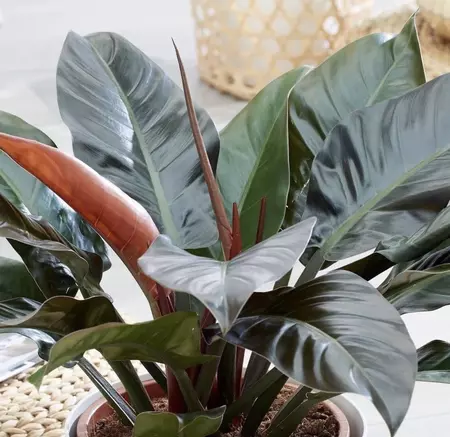
While this plant can tolerate some exposure to direct sunlight, it’s essential to be cautious about harsh, intense rays, especially during the hottest part of the day. Prolonged exposure to strong sunlight can lead to a condition known as leaf scorching. This is when the leaves develop unsightly brown or yellow patches due to excessive sun exposure.
Consider placing your Philodendron Imperial Red near a north or east-facing window when cultivating it indoors. These locations typically provide the right balance of brightness without the risk of intense direct sunlight. This allows the plant to bask in the gentle, filtered sunlight it enjoys.
It’s crucial to pay attention to the visual cues your plant provides. If it receives too much light, its leaves may become pale or bleached. Contrary to this, insufficient light can lead to leggy growth with smaller, less vibrant leaves. Moreover, low light exposure means the plant will not photosynthesize efficiently and won’t absorb the soil’s complete water, which may cause root rot.
Striking the right balance between light exposure is crucial in promoting the lush, healthy growth that makes this philodendron so captivating. If you don’t have a bright spot at your place, supplementing your plants with grow lights helps achieve the required light.
I can’t stress enough to invest in some grow lights for plants to provide sufficient light to your plants especially on short winter days. Providing a good amount of light to your Philodendron Imperial Red will reward you with long, wide glossy leaves. And we sure want that, don’t we?

Fertilizing
Fertilization provides the necessary nutrients to fuel the plant growth and maintain its vibrant appearance. Feeding your plant with nutrients is essential for plant growth and is overlooked by many plant parents due to misconception that the potting mix can provide the nutrients. Over time the potting mix loses the nutrients and become deficient in its nutritional value.
If the leaves of your plant start fading, it means they are deficient in nutrients. Without adequate nutrients, the Imperial Red may exhibit slow growth, smaller leaves, and an overall less vibrant appearance.
Fertilization should be primarily carried out during the active growing season, which typically spans spring to summer. During this period, your Imperial Red is expending energy to produce new foliage and expand its root system. To support this growth, it’s recommended to apply a balanced, water-soluble fertilizer diluted to half strength every 2-4 weeks.
Feeding your plant with high nitrogen-based all-purpose liquid fertilizers diluted to half strength twice a month is ideal in the growing season, while the fertilizer’s frequency should be reduced in the colder months.
Moreover, some plant parents prefer granular slow-release fertilizer as it reduce the chances of foliage and root burn. These granular fertilizers dissolves slowly as the plant needed, so you can’t over fertilize the plant.
If you are new to plant parenting I highly recommend trying Miracle-Grow Indoor Plant Food Spikes. These pellets are really easy to use and will not burn any foliage of your plant.
Here are some good fertilizers available on the market:
- Philodendron Plant Food, Indoor Plant Food Liquid Fertilizer
- Liqui-Dirt Nano Powder All-Purpose Organic Plant Food
- Osmocote Smart-Release Plant Food
Be careful with the usage, as over-fertilization may burn the plant. Over-fertilization can result in various problems, including mineral imbalances, salt buildup, and stunted growth. Excess nutrients can disrupt the plant’s ability to absorb water, leading to stress and potentially causing leaves to discolor or wilt.

Potting
Philodendron Imperial Red thrives in a pot container with drainage holes so air can flow through the roots to provide oxygen. Please avoid using large containers for your plant because, in big containers, the soil doesn’t dry and may stay soggy, increasing the risk of root rot.
It would be confusing for you as the top soil will look dry and you tend to overwater water your plant because the soil around the roots may still be wet. Therefore, choose the container size according to the roots of the plants.

Repotting Philodendron Imperial Red
The Philodendron Imperial Red is not a fast grower, loves to be root bound slightly, hence doesn’t need repotting often. Repotting your Imperial Red becomes necessary when the plant outgrows its current container, and it’s typically recommended every 2-3 years, preferably in the spring.
When it’s time to repot, choose a slightly larger pot than the current one. This additional space allows the plant’s roots to grow and expand comfortably. Select a fresh potting mix that aligns with the well-draining blend mentioned earlier. The new pot and mix provide your Imperial Red with a fresh start and ensure optimal growing conditions.
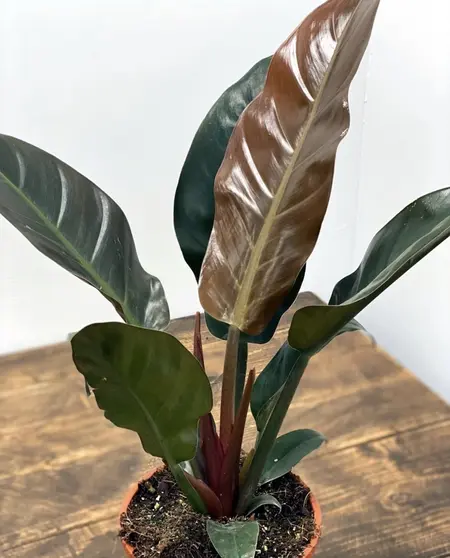
Repotting Guide
Remove the Plant
Carefully and gently remove the plant from its current container. This can often be done by tipping the pot on its side and tapping the bottom to ease the plant out. Be cautious not to damage the roots during this process.
Inspect and Prune
Once the plant is out, inspect the roots. If you notice roots circling the root ball or becoming root-bound, gently tease them out. This encourages the roots to grow outward into the new soil rather than in circles.
Replant
- Place a layer of fresh potting mix at the bottom of the new pot.
- Position your Imperial Red in the center, ensuring that the root ball sits at the same level it was in the previous pot.
- Fill the space around the plant with additional potting mix, gently pressing it down to secure the plant.
Water Thoroughly
After repotting, give your plant a thorough watering to settle the soil and eliminate air pockets around the roots.
Repotting provides the plant with the room it needs to grow and expand its root system, allowing it to access more nutrients and water.
After repotting, I usually water my plants with Clonex Clone solution. It builds a healthy, strong, and robust root system, so it helps reduce the transplant shock when you’re transplanting your plants.

Pruning and Maintenance
The Philodendron Imperial Red is an exceptional choice for indoor gardeners, regardless of their experience level. This is primarily due to its naturally low-maintenance nature, which allows it to bloom with minimal effort, making it a delightful companion for both beginners and seasoned plant enthusiasts alike.
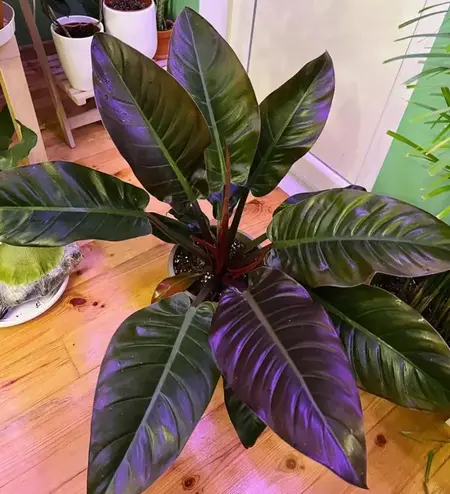
One of the few tasks required to ensure your red imperial remains a picture of health is occasional pruning. Pruning serves multiple purposes in nurturing this plant. Firstly, it encourages the development of a bushier, more compact form, enhancing its overall aesthetic appeal. By removing leggy or overgrown stems, you can help the plant maintain a lush and balanced appearance.
Moreover, trimming is a practical measure to eliminate dead or yellowing leaves. These unsightly leaves not only detract from the plant’s beauty but can also potentially sap energy that could be directed toward new growth. Trimming them away allows your Philodendron Imperial Red to redirect its resources for more vibrant and healthier foliage.
Another straightforward yet impactful practice in maintaining the beauty of your Imperial Red is gently wiping the leaves with a damp cloth. Dust and debris can accumulate on the leaves over time, hindering the plant’s ability to perform photosynthesis effectively. By removing this layer of dust, you facilitate better light absorption and, consequently, more efficient growth.

Toxicity
It’s crucial to be aware that Philodendron Imperial Red is toxic to both humans and pets. The plant contains compounds that can lead to various health issues when ingested. To ensure the safety of your loved ones, keep the plant out of reach of curious pets and children. Immediate medical attention may be required if ingestion occurs, as symptoms can range from mild irritation to more severe reactions.

Pests, Diseases & Common Problems
While the Philodendron Imperial Red is relatively low-maintenance, it’s not entirely immune to common pests and diseases. Being vigilant and proactive in addressing these issues is crucial to maintaining the health and vibrancy of your plant.
Common Pests
Spider Mites: These tiny arachnids can infest your Imperial Red, causing stippling, webbing, and a generally unhealthy appearance. Combat spider mites by regularly inspecting the undersides of leaves and treating affected areas with insecticidal soap or neem oil.
Aphids: Aphids are small, sap-sucking insects that can distort leaves and excrete a sticky substance known as honeydew, which attracts other pests. You can wash them off your plant with a strong stream of water or use insecticidal soap.
Mealybugs: Mealybugs are small, cottony insects that feed on plant sap, causing yellowing and wilting. Similar to aphids, they can be treated with insecticidal soap or neem oil.
If you see white, brown, or cream fuzzy stuff on the plant leaves, it indicates your plant is infested with mealybugs. To treat this issue, wipe the leaves and other parts of the plant with a cotton swab dipped in rubbing alcohol.
Always check the underside of the leaves as Mealybugs love to cluster there and usually go unnoticed by plant parents.
Diseases
Root Rot: This is a common issue that can arise from overwatering or poor drainage. Root rot can be challenging to spot until it’s advanced, but symptoms may include yellowing leaves, wilting, and a musty smell. If your plant depicts these signs, remove it from the pot and examine its roots; if you see black and mushy roots, your philodendron is suffering from root rot.
To treat the root rot you might need to trim the affected parts such as mushy roots and repot the plant in a fresh well, draining a chunky potting medium. In addition, placing your plant in a spot where it receives bright indirect light for at least 6 to 8 hours helps it photosynthesize effectively and lets it absorb all the water from the soil.
Moreover, to prevent root rot, ensure your plant is potted in a pot that has adequate drainage holes. Only water when the top inch of soil is dry.
Common Problems
This Philodendron can encounter various common problems, some of which include:
Leaf Browning: This can occur due to various factors, including excessive direct sunlight, low humidity, or over-fertilization. Adjusting light exposure, maintaining proper humidity levels, and following a balanced fertilization routine can help prevent this issue.
Leggy Growth: Insufficient light or crowded growing conditions can lead to leggy growth with elongated stems and fewer leaves. Ensuring adequate indirect light and providing enough space can help maintain a compact, bushy appearance.
Yellowing Leaves: Yellowing leaves may result from overwatering, root rot, or nutrient deficiencies. Adjust your watering schedule, improve drainage, and consider balanced fertilization to address these concerns.
Wilting: Wilting can be a sign of underwatering, overwatering, or temperature extremes. Adjust your watering routine, ensure proper drainage, and maintain a suitable temperature range to prevent wilting.
Stunted Growth: Stunted growth can result from various factors, including insufficient light, poor soil quality, or rootbound conditions. Addressing these factors can encourage healthy growth.

Common Queries
Is Imperial red Philodendron rare?
The Imperial Red Philodendron, while not exceedingly rare, is considered somewhat uncommon in the kingdom of Philodendron varieties. Its striking foliage and unique coloration make it a sought-after choice among plant enthusiasts, adding a touch of elegance and vibrancy to indoor spaces.
What is the difference between imperial green and imperial red?
The key distinction among these cultivars lies in the leaf color, with Imperial Red exhibiting a rich dark green-maroon hue. Imperial Red tends to have a slightly slower growth rate, and its leaf shape differs from Imperial Green, with less concavity on the leaf face and a slightly longer overall length.
What is the difference between red emerald and imperial red?
The primary difference between Red Emerald and Imperial Red Philodendrons lies in their growth habits and appearance. Red Emerald is a climbing variety, known for its vining nature and vibrant foliage. In contrast, Imperial Red is a hybrid of Philodendron erubescens, growing in a bushier, more compact manner, with deep maroon-green leaves. Additionally, it’s important to note that both plants contain oxalate crystals, making them toxic to humans and pets if ingested.
Is Philodendron Imperial Red a climber or crawler?
Philodendron Imperial Red is more like a climber. It tends to grow in a bushy and compact manner, with its stems spreading horizontally along the ground or across support structures. Unlike some other Philodendron varieties, it does not typically exhibit a strong climbing tendency.

Conclusion
The Philodendron Imperial Red is a captivating addition to any indoor space, boasting its lush green foliage with stunning red accents. By adhering to the care guidelines outlined above, you can ensure the optimal growth and longevity of this remarkable plant. With a little attention to watering, lighting, humidity, temperature, and regular maintenance, you will be rewarded with a flourishing and thriving imperial red philodendron that adds a touch of elegance and charm to your home or office.
So, what are you waiting for, grab this beauty and lit your home with its exquisiteness.
Related Posts
Alocasia Sarawakensis Yucatan Princess Care
Dear Gardeners!! If you want to add a dramatic look to your home, there is no plant better than exotic and bold Alocasia Yucatan princess. This beautiful plant flaunts large dark green crinkled glossy leaves with brown underside and velvety…
Alocasia Ivory Coast Care and Propagation Guide
Alocasia Ivory Coast is a striking houseplant featuring impressive silvery webbed flat leaves. The striking contrast between fat, rounded, dark green arrow-shaped leaves and silver veins coupled with beautiful pink petioles make this plant an exceptional exquisiteness to stand out.…
Best Carbon Filter for Grow Room and Grow Tents
Once you set up your grow room or tent and start cultivating some plants and weeds, you will begin sensing some sharp pungent smells around your household. Indoor plant cultivation, including cannabis, requires the use of fertilizers, nutrients, and pesticides,…
Alocasia Sanderiana | Kris Plant Care and Propagation Guide
Hello, plant parents! Today is about one of my favorite plant the Alocasia Sanderiana which you would find in collections of plant enthusiasts and is commonly mistaken by Alocasia Polly, Amazonica and Bambino. Alocasia Sanderiana is one of the rarest…
Alocasia Frydek Variegated Care and Propagation Guide
Alocasia Frydek Variegated is the most exotic, ultra-rare, and magnificent variety of the Araceae family, featuring an exquisite, stunning, luxurious velvety appearance that would leave anyone to fall in love with this beauty. This plant exhibits soft, velvety broad heart-shaped…

